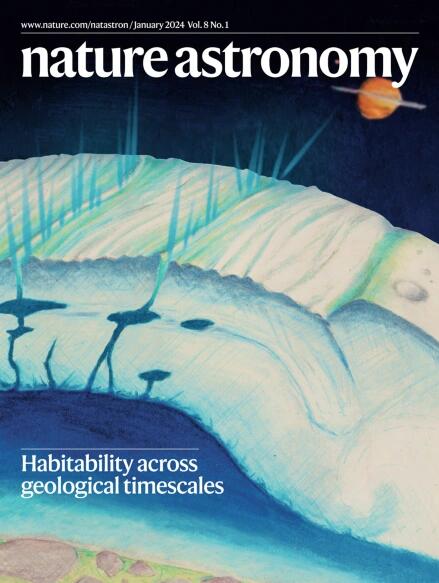从黎明号的观测中推断出灶神星的一个小核心
摘要
灶神星的大规模内部结构以前主要是利用黎明号任务的重力和形状数据来限制的。然而,这些数据本身仍然为身体的分化状态提供了广泛的可能性。转动惯量可以说是与行星体径向密度分布有关的最具诊断性的参数,对于评估行星体的内部分化状态至关重要。确定转动惯量需要额外测量小旋转运动的振幅,如进动和章动。在这里,我们报告了从黎明号通过深空网络进行的多普勒跟踪和机载成像数据推断出的灶神星转动惯量的最新估计。灶神星归一化极转动惯量恢复值为\(\bar{C}/M{R}^{2}=0.4208\pm 0.0047\) (M为灶神星质量,R为参考半径),仅为6.6% lower than the homogeneous value of 0.4505. This value, combined with the gravity field and global shape, suggests that Vesta’s interior has limited density stratification beneath its howardite–eucrite–diogenite-dominated crust. We propose two possible origin scenarios that are consistent with the observed constraints. In the first scenario, Vesta’s interior did not undergo full differentiation due to late accretion. In the second scenario, Vesta originated as an impact remnant of a larger differentiated body re-accreted with non-chondritic bulk composition produced from a catastrophic impact. Vesta did not experience complete differentiation in either scenario, suggesting that its current state reflects a complex interplay between its accretion timing, thermal evolution, redistribution of 26Al bearing melt and/or impact processes.

Vesta’s large-scale interior structure had previously been constrained primarily using the gravity and shape data from the Dawn mission. However, these data alone still allow a wide range of possibilities for the differentiation state of the body. The moment of inertia is arguably the most diagnostic parameter related to the radial density distribution of a planetary body, making it crucial for assessing the body’s state of internal differentiation. Determining the moment of inertia requires additional measurements of the amplitudes of small rotational motions, such as precession and nutation. Here we report an updated estimate of the moment of inertia of Vesta inferred from Dawn’s Doppler tracking via the Deep Space Network and onboard imaging data. The recovered value for Vesta’s normalized polar moment of inertia is \(\bar{C}/M{R}^{2}=0.4208\pm 0.0047\) (where M is the mass of Vesta and R is the reference radius), which is only 6.6% lower than the homogeneous value of 0.4505. This value, combined with the gravity field and global shape, suggests that Vesta’s interior has limited density stratification beneath its howardite–eucrite–diogenite-dominated crust. We propose two possible origin scenarios that are consistent with the observed constraints. In the first scenario, Vesta’s interior did not undergo full differentiation due to late accretion. In the second scenario, Vesta originated as an impact remnant of a larger differentiated body re-accreted with non-chondritic bulk composition produced from a catastrophic impact. Vesta did not experience complete differentiation in either scenario, suggesting that its current state reflects a complex interplay between its accretion timing, thermal evolution, redistribution of 26Al bearing melt and/or impact processes.

 求助内容:
求助内容: 应助结果提醒方式:
应助结果提醒方式:


